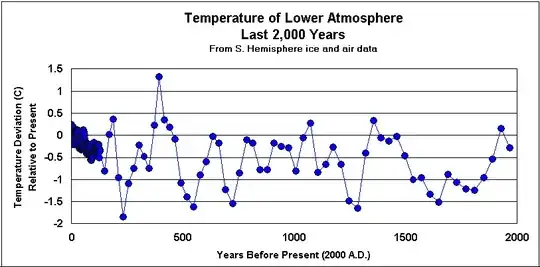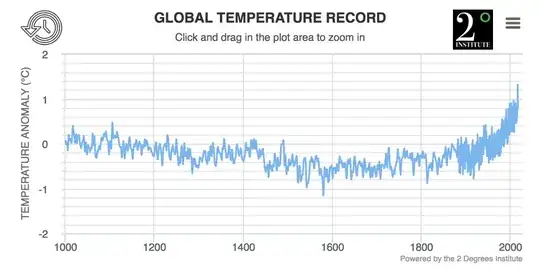Because you did not provide a source for those figures, I took the liberty of performing a reverse image search to find them.

The first image is taken from Geocraft, a webpage which contains miscellaneous articles on geology-adjacent topics and, in particular, a section dedicated to the discrediting of anthropogenic climate change. The figure in question was ostensibly generated from a composite data set incorporating a historical $^{18}$O isotope record from the Vostok ice core taken from Eastern Antarctica and covering the period prior to 1871, southern hemisphere ground temperature data covering the period from 1871 to 1979, and satellite data covering the period from 1979 to the "present day" (though the page in question seems not to have been updated in the last 10-15 years).
I could find no references for the satellite data nor for the ground temperature data, so I have no means to reconstruct the plot myself. I can not explain why the time resolution appears to be $\sim 2$ data points per century, not can I say precisely how the data for the figure in question is calculated. Naïvely I would imagine that "Temperature deviation relative to present" means $T - T_{present}$ (whenever "present" is), but that would suggest that the final data point should be 0 (and of course, I have no idea what that temperature is meant to refer to - presumably some kind of average). Overall, the opacity of this data does not inspire confidence in the analysis and good-faith presentation, and so I personally do not find it the slightest bit compelling.

This data comes from the 2 Degrees Institute, an organization whose stated goal is to prevent the temperature anomaly displayed in the above figure from exceeding $2^\circ$ C. This figure was generated from a composite of proxy data (specifically, lake and ocean sediments and tree ring data) and the GISS Global Surface Temperature Analysis, which is based on land and sea meteorological measurements.
The answer to your question is provided by the GISS FAQ page:
Q. What are temperature anomalies (and why prefer them to absolute temperatures)?
A. Temperature anomalies indicate how much warmer or colder it is than normal for a particular place and time. For the GISS analysis, normal always means the average over the 30-year period 1951-1980 for that place and time of year. This base period is specific to GISS, not universal. But note that trends do not depend on the choice of the base period: If the absolute temperature at a specific location is 2 degrees higher than a year ago, so is the corresponding temperature anomaly, no matter what base period is selected, since the normal temperature used as base point (which is subtracted from the absolute temperature to get the anomaly) is the same for both years.
Note that regional mean anomalies (in particular global anomalies) are not computed from the current absolute mean and the 1951-80 mean for that region, but from station temperature anomalies. Finding absolute regional means encounters significant difficulties that create large uncertainties. This is why the GISS analysis deals with anomalies rather than absolute temperatures. For a more detailed discussion of that topic, please see "The Elusive Absolute Temperature".
If you are interested in reconstructing the GISS data yourself, all of the necessary resources (including the raw data files) can be found here. The data from the Nature paper can be found as supplementary data here.
I will leave it to you to decide which sources you find more compelling and for which reasons.


